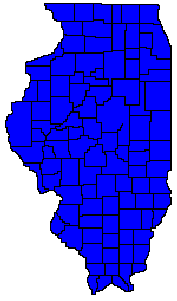 |
| Black
Willow (Salix nigra)
Distribution
Map to Right |

Most of the North American willows are shrubby, but black willow is the most distinctive as a tree. It is a small to medium tree. On some sites it can reach heights of 90 feet, but it grows mostly to between 30 and 40 feet tall. It has a short trunk with a diameter of up to 3 feet. The crown is spreading and is usually rounded, but can be open and irregular.
Black willow occurs in every county in Illinois on wet ground, most commonly along rivers and streams. It is widespread throughout the entire eastern United States with the exception of Florida, from which it is absent. Its spreading, shallow roots need a continuous supply of moisture throughout the growing season, and it is most abundant on floodplains and in swamps and sloughs. It occurs in pure stands in floodplains throughout its range.
Interesting
Facts
Black
willow is extremely tolerant of flooding and can withstand burial by sediments
accompanying big floods. The branching root system stabilizes the tree
in the shifting soil. The root system is also good for stabilizing soils
and the black willow is an effective choice for erosion control.
Black willow cannot grow well in shade. Its seeds must germinate within a day or two after they are shed. They are dispersed by wind and water, and they are often deposited along streams and on sand bars, where they grow into pure even-aged stands.
Identifying Features
BarkUses
Black willow bark is dark brown or black, rough and furrowed, with older trunks bearing shaggy or scaly bark.
Twigs
The twigs are slender, pale orange or olive green (when young), becoming darker or brownish red with age. They are smooth and brittle and droop slightly at maturity.
Buds
There are no terminal buds. Lateral buds are small and reddish brown.
Leaves
The leaves are alternate, simple, and lance shaped. They are very narrow, pointed at the tip, with very fine teeth along the edges. The base is tapered or wedge shaped. They are from 2-6 inches long, green and smooth on the upper surface, and lighter and smooth or hairy along the veins below. The leafstalks are short.
Flowers
Black willow is dioecious, male and female flowers occurring on separate trees. The flowers are rather indistinct. Both male and female (staminate and pistillate, respectively) are crowded into long catkins, appearing in early spring at leafout.
Fruits
Fruits are two-valved, reddish-brown capsules occurring as several crowded together in hanging clusters 3-6 inches long.
Black willow wood is light-weight, soft and weak. It is used for pulpwood, charcoal, flooring, boxes and crates, and veneer. It was once used for artificial limbs because of its light weight and the fact that it glued well and is easily worked with tools. Glucoside salicin, the original basic ingredient of aspirin, was extracted from the leaves and bark of the tree in the early 19th century. Today the chemical (salicylic acid) is synthesized rather than extracted.